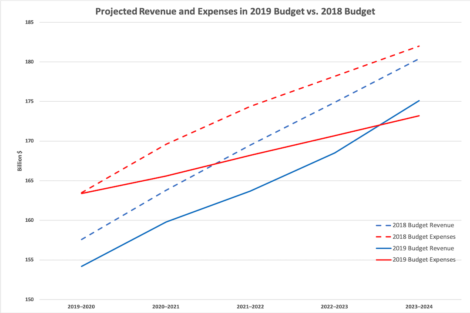The Ontario 2019 budget, announced April 11 by Minister of Finance Victor Fedeli, outlines the government’s intention to reduce the provincial deficit and achieve a balanced budget by 2023–2024. The budget projects $154.2 billion in revenue and $163.4 billion in expenses in 2019–2020, exceeding estimated 2018–2019 expenses by approximately $900 million. Over the next five years, the budget projects a cumulative $821.3 billion in revenue and $841.1 billion in expenses, for a net $19.8 billion deficit over this period.
As part of the province’s recovery plan, total annual revenue is estimated to grow at an average of three per cent, while expenditure will increase by an annual average of one percent. The 2023–2024 period is projected to have a “modest surplus” of $1.9 billion.

Economic and fiscal outlook
The government’s 2019–2020 plans will see net debt increase by $16.5 billion to $359.9 billion; accumulated deficit will increase by $9.3 billion to $230 billion. Ontario has the largest subnational debt in the world, for which the government will shell out $13.3 billion in interest payments in 2019–2020.
Current projected debt and deficit are greater than projections in the previous Liberal government’s budget, primarily owing to actual 2017–2018 figures being higher than previously estimated. Doug Ford’s government consequently inherited a $15 billion deficit, which it has since reduced to $11.7 billion.
The budget’s medium-term projections show that net debt will increase to $372.3 billion in 2020–2021 and $382.4 billion in 2021–2022. Accumulated deficit will rise to $235.8 billion and $240.4 billion in the same periods, respectively. This is also up from the previous budget’s 2020–2021 estimation of a $360.1 billion net debt and $212.3 billion deficit.
Owing to a “less supportive external environment,” Ontario’s economic growth is expected to slow, with real and nominal gross domestic product (GDP) growth projections down from last year’s projections. The 2019 budget projects a 1.4 per cent real GDP growth and a 3.4 per cent nominal GDP growth in 2019, compared to the previous budget’s 1.8 per cent and 3.9 per cent projections. Government planning assumptions partially rely on consultations with private sector economists; in February, U of T projected that Ontario’s real GDP would grow by two per cent in 2019.
Employment growth in 2019 is forecast to grow from a previous 1.1 per cent in the 2018 budget to 1.3 per cent. Job creation is one of the government’s core commitments and, to this end, the budget notes that 132,000 net new jobs have been created since June 2018.
Infrastructure expenditure is slated to total $14.7 billion in 2019–2020, with the bulk of this coming from $8.6 billion in the transportation sector; $351 million will go to postsecondary education and training infrastructure.
Postsecondary education expenses will drop from $12.1 billion in 2018–2019 to $11.4 billion in 2019–2020.
Commercialization opportunities
The budget also includes plans to strengthen the province’s intellectual property (IP) position and increase commercialization opportunities. The government will create an expert panel that will oversee the planning of a provincial IP framework particularly geared toward the postsecondary education sector.
In addition to the wealth of research it produces, U of T is also a leading university-based entrepreneurial hub, with over 500 research-based startups launched across its 10 accelerators and incubators over the past decade.
Details on this panel’s constitution and the processes that will be involved in creating its framework remain sparse. According to the budget, “this panel will potentially include representation from the postsecondary, industry, innovation, venture capital and investment, banking and finance sectors, as well as from medical research and intellectual property legal expertise.”
While the province does not currently have a framework for IP in place, the federal government launched its Intellectual Property Strategy in 2018 and U of T has its own Inventions Policy, which outlines the commercialization processes for U of T-associated research.


